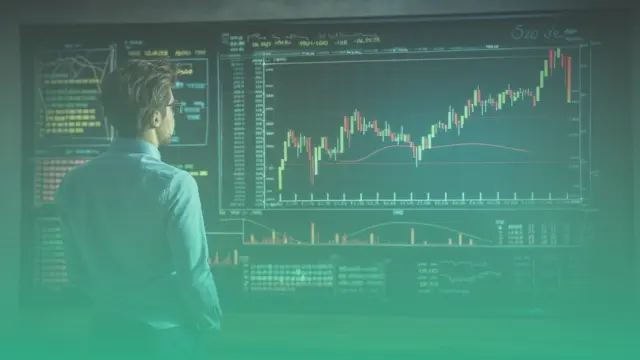Introduction
In the rapidly evolving world of automated trading, evaluating trading bot performance has become a cornerstone for achieving financial success. This guide delves into the essential metrics that illuminate the efficiency and reliability of trading bots across diverse market conditions. By understanding these key indicators, traders can fine-tune their strategies, ensuring their bots not only navigate market complexities but thrive. From profitability and risk management to execution speed and accuracy, we explore the pivotal roles these metrics play in crafting a robust trading bot strategy. Our aim is to arm traders with the knowledge to make well-informed decisions, optimizing their automated trading systems for peak performance.
Understanding Key Performance Metrics
The success of a trading bot hinges on a set of specific metrics, each serving as a crucial indicator of its performance. Let’s break down these key metrics to understand how they contribute to evaluating a trading bot’s effectiveness.
- Profitability Metrics: The primary goal of any trading bot is to be profitable. Understanding these key indicators, such as Return on Investment (ROI) and profit factor, traders can fine-tune their strategie. They provide a clear picture of the bot’s ability to generate financial gains over a period. A higher ROI or profit factor typically indicates a more successful trading bot.
- Risk Management Metrics: In the unpredictable world of trading, managing risk is as important as achieving profits. Metrics such as the risk-reward ratio and drawdown percentage are vital. They help assess how well a bot can navigate market fluctuations while safeguarding the capital invested. A lower drawdown percentage or a favorable risk-reward ratio often signifies a bot that’s better at managing risks.
- Execution Speed Metrics: In markets where opportunities can vanish in milliseconds, the speed at which a bot executes trades is crucial. Metrics that measure order execution time and latency give insights into the bot’s responsiveness and efficiency. Faster execution can mean the difference between capitalizing on an opportunity and missing it entirely.
- Win Rate Metrics: This is about the bot’s accuracy in executing profitable trades. A higher win rate suggests a bot that is more adept at identifying and capitalizing on profitable market movements.
Together, these metrics provide a holistic view of a trading bot’s performance. By understanding and analyzing these indicators, traders can make more informed decisions about employing and tweaking their bots for optimal performance. The key is to not only look at these metrics individually but also to understand how they interact with each other, painting a comprehensive picture of the bot’s overall effectiveness in the dynamic trading environment.
The Role of Risk-Adjusted Returns
When evaluating trading bots, looking beyond mere profitability to understand risk-adjusted returns is crucial. This section delves into what risk-adjusted returns are and why they are a critical aspect of assessing trading bot performance.
This concept revolves around measuring how much risk is undertaken to achieve a bot’s returns. It’s not just about the returns; it’s about balancing those returns with the risks incurred to achieve them. In the unpredictable world of trading, a strategy that yields high returns at extremely high risk levels might not be sustainable in the long run.
Key Metrics for Risk-Adjusted Returns
- Sharpe Ratio: This ratio measures the excess return (over a risk-free rate) per unit of risk (standard deviation). A higher Sharpe ratio indicates a more desirable risk-adjusted return. It’s a way to understand if the extra returns of a trading bot are due to smart investment decisions or a result of taking higher risk.
- Sortino Ratio: Similar to the Sharpe ratio, but with a focus on downside risk. It measures the excess return over the risk-free rate relative to the downside risk (standard deviation of negative asset returns). This ratio is particularly useful for traders who are more concerned about the downside risk than the overall volatility.
In a volatile market, it’s not just about making profits, but also about how those profits are made. High returns achieved by taking on excessive risk can lead to significant losses in adverse market conditions. Risk-adjusted return metrics provide a more nuanced view of a bot’s performance, considering both the returns and the risks involved in achieving those returns.
By analyzing these metrics, traders can align their risk tolerance with their trading strategy. This helps in choosing a trading bot that not only aligns with their financial goals but also fits their risk profile.
Analyzing Drawdown for Risk Management

Drawdown is a critical metric for assessing the risk management capabilities of a trading bot. It represents the peak-to-trough decline during a specific period, providing a clear picture of the maximum loss experienced by the bot. Understanding and managing drawdown is essential, as explored in our detailed guide on managing risk in automated trading.
Drawdown offers insight into the bot’s ability to weather market downturns. A significant drawdown indicates a higher risk level, suggesting the bot may incur substantial losses during volatile market conditions. Conversely, a lower drawdown points to a more conservative trading approach, prioritizing capital protection over aggressive trading tactics.
Effective risk management strategies aim to limit drawdowns, which is essential for preserving capital and ensuring long-term trading success. This can include setting stop-loss orders, controlling position sizes, and diversifying trading strategies. By analyzing the drawdown history of a bot, traders can identify patterns and make informed decisions about whether the bot aligns with their risk tolerance and investment goals. For a comprehensive understanding of these strategies, explore our guide on optimizing trading bot performance for risk management.
Moreover, drawdown analysis is not just about measuring past performance. It’s also a tool for proactive strategy adjustment. If a trading bot consistently experiences high drawdowns, it may indicate the need for strategy optimization to reduce risk exposure.
The Importance of Consistency in Performance
Consistency is a key factor in evaluating the performance of trading bots. A bot that performs well consistently across different market conditions and timeframes is more reliable and potentially more profitable in the long run.
Consistency in performance means more than just achieving positive results in a single market scenario. It involves the bot’s ability to adapt and maintain profitability across various market conditions—be it in bullish, bearish, or volatile markets. A bot that can navigate through these differing conditions demonstrates robustness and versatility, key attributes for long-term success.
Another aspect of consistency is the bot’s performance over different timeframes. A bot might perform exceptionally well in the short term but fail to sustain these results in the long run. Evaluating performance over various periods can help traders understand whether the bot’s strategies are short-term gains or sustainable long-term strategies.
Benchmarking a bot’s performance against relevant market indices is also a useful way to gauge its consistency. This comparison can show whether the bot is truly outperforming the market or simply riding the wave of broader market movements.
Lastly, the ability of a bot to adapt to changing market trends is a critical component of its consistency. Financial markets are dynamic, and a bot that can adjust its strategies in response to these changes is more likely to maintain consistent performance. For an in-depth look at how to continuously evaluate and adapt trading strategies to maintain this consistency, visit our guide on the evolution of trading software from basic tools to advanced platforms. This resource provides valuable insights into leveraging software advancements for optimizing trading bot adaptability and performance over time.
Backtesting: A Crucial Step in Performance Evaluation
Backtesting is an indispensable process, as detailed in our article on the importance of backtesting in automated trading. It involves simulating the bot’s strategy with historical market data to estimate how it would have performed in the past. This method provides a valuable perspective on the viability and potential success of the bot’s strategies.
The importance of backtesting lies in its ability to uncover strengths and weaknesses in a trading bot’s strategy before it is deployed in live markets. By applying the bot’s algorithms to historical data, traders can identify how the bot would have responded to various market conditions and adjust strategies accordingly.
Risk mitigation is a significant aspect of backtesting. It allows traders to anticipate potential pitfalls and modify strategies to minimize losses. This is especially crucial in the volatile world of trading, where market conditions can change rapidly and unpredictably.
Strategy refinement is another key benefit of backtesting. The results enable traders to fine-tune their bots, optimizing entry and exit points, improving risk management tactics, and adapting to changing market conditions. This iterative process helps in developing a more robust and effective trading bot.
Backtesting also provides realistic insights into a bot’s potential performance, setting realistic expectations for traders. Knowing how a bot performed historically prepares traders for the possible outcomes and reduces the emotional impact of any losses that may occur.
YourRoboTrader’s Bot Analytics
YourRoboTrader stands out in the automated trading landscape, much like our comprehensive review of Cryptohopper demonstrates. At the core of their offerings is the development of customized trading bots. This bespoke approach ensures that each trading bot is tailored to meet the specific needs and preferences of individual traders, incorporating a variety of strategies and indicators to optimize performance.
The development of advanced indicators is another area where YourRoboTrader excels. These indicators, used by professional traders, are crucial in enhancing the efficiency and effectiveness of the trading experience. They provide nuanced market insights, aiding in better decision-making and improving the predictive accuracy of trading bots.
A significant aspect of YourRoboTrader’s service is the provision of historical analysis. This feature allows traders to review the performance of their trading bots on simulated trading accounts, offering valuable backtesting data. Such historical analysis is essential in evaluating how a bot would have performed under various past market conditions, helping traders refine strategies and make informed decisions about future trades.
Additionally, YourRoboTrader offers modification and debugging services for trading bots. This is crucial in the fast-evolving world of automated trading, where bots need to be regularly updated and optimized to maintain peak performance. The ability to modify and debug ensures that trading bots continue to operate efficiently and adapt to new market trends and strategies.
Overall, YourRoboTrader provides a robust and dynamic platform for automated trading. By focusing on customization, advanced indicators, historical analysis, and continuous improvement of trading bots, they offer traders a powerful tool for enhancing their trading strategies and achieving better market outcomes.
In Conclusion
Evaluating the performance of trading bots is a multifaceted process that requires a deep understanding of various metrics and indicators. From profitability and risk management metrics to execution speed and consistency in performance, each factor plays a crucial role in determining a bot’s effectiveness. The use of advanced analytics, such as risk-adjusted returns and drawdown analysis, further enhances this evaluation, providing a more nuanced view of a bot’s ability to navigate the complexities of the market.
The incorporation of services like those offered by YourRoboTrader—customized bot development, advanced indicators, historical analysis, and continuous modification—exemplifies the comprehensive approach needed for successful automated trading. These tools and services are essential for adapting to the dynamic nature of financial markets, ensuring that trading bots remain effective and aligned with traders’ evolving strategies and risk appetites.
Ultimately, the key to successful trading bot performance lies in continuous monitoring, adaptation, and refinement of strategies. Whether you are a seasoned trader or new to the world of algorithmic trading, understanding and effectively applying these metrics and tools is essential for optimizing trading outcomes. By staying informed and agile in strategy implementation, traders can maximize the potential of their trading bots, achieving sustainable profitability and risk management in the ever-changing landscape of financial trading.
For those new to the world of algorithmic trading, understanding these metrics is just the beginning. Dive deeper into our ultimate guide to automated trading systems for more insights.




